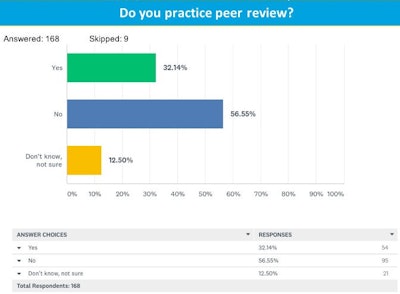
More must be done to make peer review systematic and better integrated into workflow, delegates at the French national radiology congress (JFR) heard on Saturday. Furthermore, many French radiologists may fear review but unwittingly are doing it anyway, resulting in wide variation in practice across centers.
 Dr. Nadya Pyatigorskaya, PhD.
Dr. Nadya Pyatigorskaya, PhD.Addressing delegates in her presentation during the session on quality, Dr. Nadya Pyatigorskaya, PhD, neuroradiologist at Pitié Salpêtrière hospital in Paris, urged departments to adopt an official peer-review strategy, and suggested how France might learn from existing systems in other countries.
While teleradiology companies engage in regular peer-review activities for quality assurance purposes, other French radiologists are less prone to do so because they generally fear being judged and punished, she noted.
This prevalent attitude is not just a French problem. Pyatigorskaya pointed to a 2018 peer-review survey conducted by the European Society of Neuroradiology (ESNR) that generated 177 responses among members, showing a wide range of attitudes.
For the question on peer-review practice, there were 168 responses: 32.1% (54) said they participated in peer review, around 56.6% (95) said they didn't, and 12.5% (21) said they weren't sure if they participated or not. Of those that indicated participation in peer review, around 12% said peer review was systematic, while the rest stated their participation was more irregular, usually during multidisciplinary meetings or upon request of the clinician.
 Peer-review practice across 168 European neuroradiologists, Figure courtesy of Dr. Nadya Pyatigorskaya and the European Society of Neuroradiology.
Peer-review practice across 168 European neuroradiologists, Figure courtesy of Dr. Nadya Pyatigorskaya and the European Society of Neuroradiology."Most radiologists submitting to peer review do so in an ad hoc manner, such as in team or case meetings where reports will be discussed and the exam read again by someone else. It's important, however, that radiologists get regular feedback on their performance, which will ultimately improve quality for patients," Pyatigorskaya noted.
Far from being a punitive system, strategies could involve anonymizing reports to be reviewed, with feedback in case of discrepancy delivered during team or department meetings, as is the case in the U.S. and the U.K., according to Pyatigorskaya. In her talk, she flagged a U.S. survey that revealed 50% satisfaction with the review system and a sense that it improved work, while 50% of respondents felt it was administratively too time-consuming.
Alternatively, Canada's system of semianonymity during peer review could also prove helpful -- and encouraging, Pyatigorskaya continued. In this setup, anonymized reports are read by a reviewer, but the feedback -- whether it concurs with the diagnosis or not -- is delivered directly to the initial reporting radiologist.
"It is crucial to raise awareness that radiologists should take part in this activity, though it is also important for morale, motivation, and adhesion for peer review to remain nonmandatory," she noted. "There is no society initiative to try to make peer review obligatory, even though niche groups such as teleradiologists may impose this for their own group members."
For Pyatigorskaya the answer lies in helping radiologists realize they are already undertaking peer review in a less formalized and nonjudgmental manner, and this realization may take the fear out of engaging in it systematically.
Pyatigorskaya envisages a department where PACS randomly selects a report submitted that day, anonymizes it, and sends it to a reviewing radiologist within the hospital group. One week could then be allowed for review and delivery of findings.
She suggested that one report per week per radiologist might not be too burdensome as a peer review workload, with anonymized review discrepancies brought up during team meetings, and patients informed only when diagnoses are changed as a result.
"Radiologists already review their colleagues' work in practice, so let's make it better quality, do more of it, and better integrate it into hospital workflow," Pyatigorskaya said.



















